From gift to galaxy: Flandrau Science Center & Planetarium turns 50
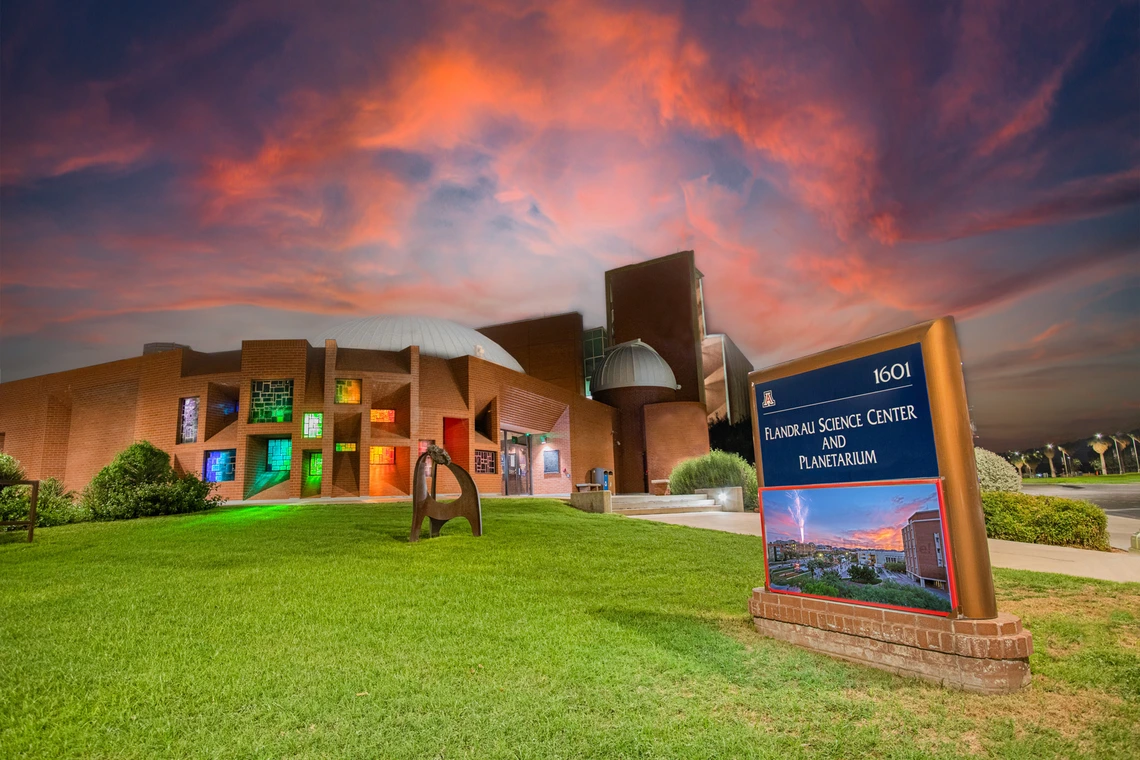
The Flandrau Science Center & Planetarium opened its doors on December 13, 1975, and for 50 years has shared the University of Arizona's research with Southern Arizona and beyond. The center features a nationally recognized planetarium, two floors of interactive science exhibits and resources designed for both educators and students.
Flandrau Science Center & Planetarium
When the estate of Grace H. Flandrau bequeathed more than $800,000 to the University of Arizona in 1972, the goal was clear: build the future crown jewel of the university's astronomical mission. That dream became reality three years later, when the Grace H. Flandrau Planetarium opened its doors on Dec. 13, 1975.
Now known as the Flandrau Science Center & Planetarium, the institution celebrates its 50th birthday this year, and its scientific mission remains alive and well.
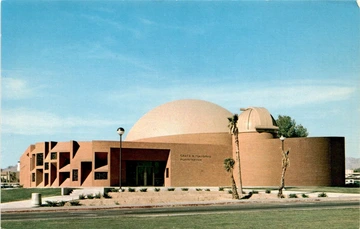
The exterior of the Flandrau Science Center & Planetarium shortly after opening in 1975.
Flandrau Science Center & Planetarium
"Flandrau is a gateway to the University of Arizona, and we excel at helping people have fun while exploring science," said Kellee Campbell, Flandrau's executive director. "Universities are places of learning, discovery and opportunity, and I think it's incredible that a place like Flandrau can share that work with the community."
Located on the University of Arizona Mall, Flandrau is home to a nationally recognized planetarium, two floors of curiosity-quenching science exhibits, community programs and resources for teachers and students of all ages – and welcomes more than 69,000 guests every year.
"Flandrau Science Center & Planetarium shares world-class research at the University of Arizona with the southern Arizona community and beyond, sparking curiosity and making science accessible for learners of all ages and backgrounds," said Carmala Garzione, dean of the College of Science. "By opening doors to discovery, Flandrau embodies the University of Arizona's land-grant mission through interactive community engagement that inspires the next generation of scientists and problem-solvers."
A vision for the future
In the decades before Flandrau was built, the U of A had already positioned itself as a leader in space sciences. The Steward Observatory was founded in 1916 and dedicated its first research telescope in 1923. The facility soon became a vital resource for the emerging Department of Astronomy and led to innovations in planetary and optical sciences. Once lunar missions took shape in the 1960s, the U of A became a hotbed for research involving spacecraft.
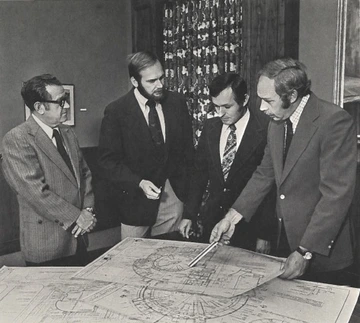
From left to right: University Vice President A. Richard Kassander, President John P. Schaefer, planetarium director O. Richard Norton and planetarium architect Rex. E. Willoughby discussing construction plans.
Flandrau Science Center & Planetarium
Before long, it became clear to then-President John P. Schaefer that the university would greatly benefit from a planetarium. Schaefer developed his vision alongside Vice President A. Richard Kassander and professor Ray Weymann, who led the astronomy department.
While the trio were responsible for the planetarium's initial development, it was Flandrau's donation that breathed life into the project.
But who was Grace H. Flandrau?
Born Grace Hodgson in St. Paul, Minnesota, around 1890, Flandrau was the daughter of Edward J. Hodgson and Mary Staples Hodgson. Flandrau attended school in St. Paul before finishing her studies in Paris.
Flandrau married her husband, William Blair Flandrau, in 1909. The couple moved to Mexico to operate coffee plantations. While there, Flandrau began her writing career. The author of several novels, historical pamphlets and literary reviews, Flandrau was also a columnist and travel writer.
After her husband passed away in 1938, Flandrau started visiting family in Tucson, purchasing a home in the region in 1960. When she passed away on Dec. 27, 1971, in Farmington, Connecticut, her estate was worth nearly $10 million.
With the donation in hand, the Arizona Board of Regents formally established the Grace H. Flandrau Planetarium in 1972 to support university departments and research, provide K-12 science instruction and promote a greater public understanding of science. President Schaefer broke ground on the facility on July 3, 1974, with a staged explosion and mock laser to emphasize Flandrau's expected contributions to the scientific community.
Read the institution's official history or visit the temporary exhibit to discover more about its first 50 years.
Where wonder meets discovery
One of Flandrau's signature experiences takes place within its planetarium, a space where audiences can journey from black holes to coral reefs without ever leaving their seats. What began in the 1970s with shows painstakingly filmed and produced in-house has evolved into a dome filled with cutting-edge productions that weave U of A research into captivating stories.
Behind the scenes, there is a team that is hard-at-work making those journeys both engaging and educational. Among them is Shiloe Fontes, planetarium, technology and design manager. Fontes oversees theater operations and graphic design for everything from exhibits to printed materials. She also co-manages several dozen undergraduate student employees and operates the downstairs "Undersea Discovery" exhibit.
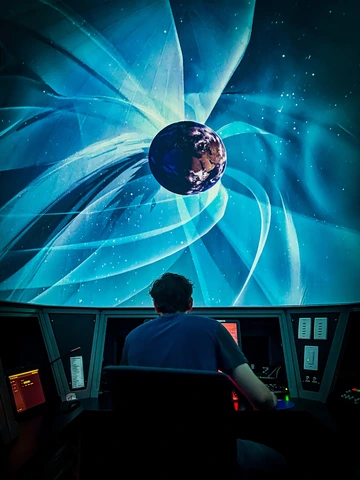
A Flandrau employee operating the 146-seat EOS Foundation Planetarium Theater, which hosts educational programming and Flandrau's popular laser light shows.
Shiloe Fontes/Flandrau Science Center & Planetarium
"There are so many interesting things happening at the University of Arizona that we can incorporate," Fontes said. "Our black holes show talks about the Event Horizon Telescope images, and the U of A was a part of that team. We've also highlighted OSIRIS-REx, OSIRIS-APEX, the James Webb Space Telescope, extreme weather conditions and climate research, marine biology and more – all under our dome in the middle of the desert."
Though the planetarium schedule is filled with scientific exploration, Fontes said the theater has always hosted a variety of laser light music shows, "for pure entertainment."
Working alongside Fontes to foster scientific wonder and inquiry throughout Flandrau is Bill Plant, director of exhibits.
Whether investigating micro- or macroscopic concepts, Plant's goal is to make science accessible to as many people as possible. While Flandrau's primary audience is school-aged children and their teachers, visitors of all ages and backgrounds will find something to satisfy their scientific inquiry.
Accessibility means different things to different people, Plant said, so Flandrau must cater to a wide range of abilities, interest and knowledge levels.
"An 'accessible' exhibit not only ensures access to someone in a wheelchair, hearing or visually impaired," he said. "We also want to ensure that someone who enjoys lighthearted humor has just as much to enjoy as someone who likes a more serious exhibit. No matter the case, a successful exhibit is one where people leave inspired to think differently or more deeply about the exhibit and the world around them."
Plant and his colleagues are currently developing "Mysteries of the Cosmos," a new exhibit set to open in 2026 that will take guests through the past decade of space exploration while also exploring the questions surrounding extraterrestrial life.
A legacy in the stars
Once a shared dream between university administrators, the Flandrau Science Center & Planetarium has become a hallmark of the U of A's dedication to exploring the universe.
Despite decades of changes within its walls, executive director Campbell said Flandrau's goal has remained largely the same.
"Universities are places of learning, discovery and opportunity, and we want people to understand all of the amazing things happening in their backyard," she said. "Only 9% of universities in the United States have a planetarium, but not all have public programming. That means the University of Arizona has dedicated the time and effort to providing the public with a place to explore the wonders of science."
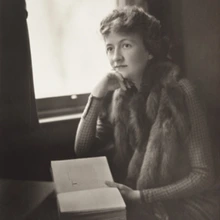
Grace H Flandrau, in the early 1920's.
Flandrau Science Center & Planetarium
Flandrau has big plans in place for this golden jubilee year, including free admission on Saturday, Dec. 13. As they near the actual birthday, the institution will host planetarium presentations with nods to the original programming as well as a new, temporary exhibit showcasing the facility's history.
The upcoming celebrations not only honor a milestone but reflect the enduring impact of Grace Flandrau's generosity. While she never saw the planetarium that bears her name, her gift inspired generations of visitors and future scientists. Those who carry her legacy in the modern era think she would be amazed by what the facility has become.
"If Grace Flandrau could see this place, I hope that 'Wow' would be the first words out of her mouth," Plant said. "I would love for her to see groups of students exploring the exhibits while other visitors sit in the planetarium with their mouths agape as we approach the surface of Jupiter. I think she would be proud of what her gift afforded this community."





